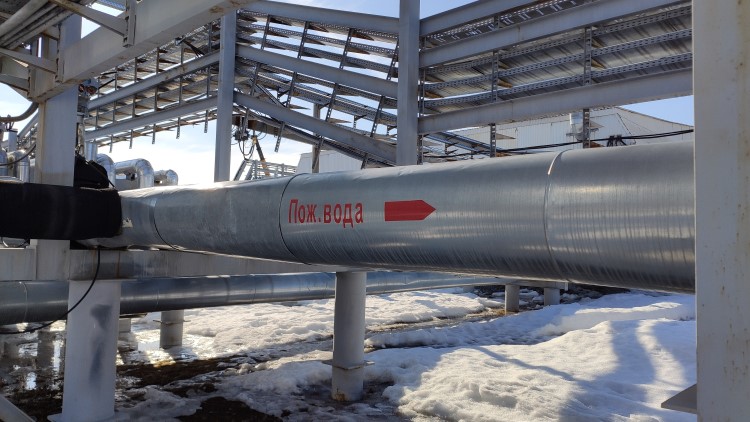Russia Increases Gas Flows to Europe, and Prices Fall
MOSCOW/OSLO (Reuters) — Russia increased its flow of gas to Europe via Poland and Belarus as well as Ukraine on Wednesday, easing some of Europe's concerns about tight supplies before winter and pushing down wholesale prices.

Low flows to Europe and reverse flows on the Yamal-Europe pipeline last week - meaning gas flowed eastwards into Poland instead of westbound into Germany - had worsened a supply squeeze in Europe that has driven up prices for industry and consumers.
But Russia started pumping gas to Germany again late on Monday, acting on an order by President Vladimir Putin to increase supplies to Europe and rebuild Russian inventories there once domestic storage tanks were replenished.
On Tuesday, Russian state gas company Gazprom said it had started to refill its European gas storage. This pushed down spot prices in the region although analysts said Moscow would have to do more to ease concerns in Europe to lead to a more significant drop.
Entry flows into Germany via the Yamal-Europe pipeline, which runs through Belarus and Poland, had risen to around 12.5 million kilowatt hours (kWh) per hour at the Mallnow metering point on the Polish border, up from 9.8 million kWh/hour most of the previous day, data on German transmission company Gascade's website showed.
While Mallnow flows were at their highest volume in weeks, they remained "well below" levels seen in September, analysts at data company Refinitiv said in a note.
"The flows are unlikely to keep growing as only 325 GWh/d of Mallnow's entry capacity was booked for November," they said.
Despite their comments, Gazprom booked additional within-day capacity at Mallnow on Wednesday morning, increasing its flow to Germany further, said Tom Marzec-Manser, head of gas analytics at commodity intelligence service ICIS.
Meanwhile, nominations for flows at Velke Kapusany on the Slovak-Ukraine border, stood at 94.3 million cubic meters (MMcm) per day, the highest daily nomination this year, website data from Eustream, the Slovak transmission system operator, showed.
That was up from 85.2 MMcm/day on Tuesday.
In a sign of concerns in Europe easing, the Dutch front-month gas contract - a European benchmark - fell as much as 9% to its lowest level since Nov. 2 on Wednesday, and was still down nearly 4% at 67.40 euros per megawatt hour (MWh) by 1430 GMT.
"Further daily capacity bookings above the 30mcm/day rate at Mallnow later this week and month will reassure the market further. But we would need a significant increase at Mallnow, with onward injections into storages, to really offset the withdrawals occurring at non-Gazprom owned units and therefore improve the supply view into Q1 2022," Marzec-Manser said.
STORAGE FACILITIES
Gas prices have risen this year because of factors including low gas inventories and increased demand following the economic recovery since the easing of COVID-19 lockdowns, as well as tighter-than-usual supplies from Russia.
In Britain, some energy companies have gone bust, consumers face much higher energy bills and companies in many sectors including food production and agriculture have felt the pain.
Internet data displayed by Gazprom-owned German storage company Astora showed the Rehden storage facility in Germany had been steadily receiving 406,875 kWh per hour of gas from early Tuesday.
At Germany's Jemgum storage facility, and Austria's Haidach, there were no receipts on Wednesday morning but volumes were being withdrawn at rates of 1,115,086 kWh/h and 3,772,347 kWh/ respectively.
Overall European gas storage levels stood at 75.6% of capacity on Monday compared with 93.9% a year earlier, data from infrastructure group GIE showed.
The resumption of Russian gas flows to Germany at Mallnow and small storage injections Rehden have calmed traders' nerves, Emily McClain, senior gas markets analyst at Rystad energy, said in a weekly report.
"How much they can send is still unclear, but based on historical trade flows during the Oct-November period, we estimate that around 2 Bcm of additional volumes may be available before the end of the year. What is clear, however, is that this remains less than adequate for a severe winter," McClain added.
Related News
Related News

- Keystone Oil Pipeline Resumes Operations After Temporary Shutdown
- Freeport LNG Plant Runs Near Zero Consumption for Fifth Day
- Biden Administration Buys Oil for Emergency Reserve Above Target Price
- Mexico Seizes Air Liquide's Hydrogen Plant at Pemex Refinery
- Enbridge to Invest $500 Million in Pipeline Assets, Including Expansion of 850-Mile Gray Oak Pipeline




Comments